The Jimmy Book Club: 15 Books that Transformed My Work
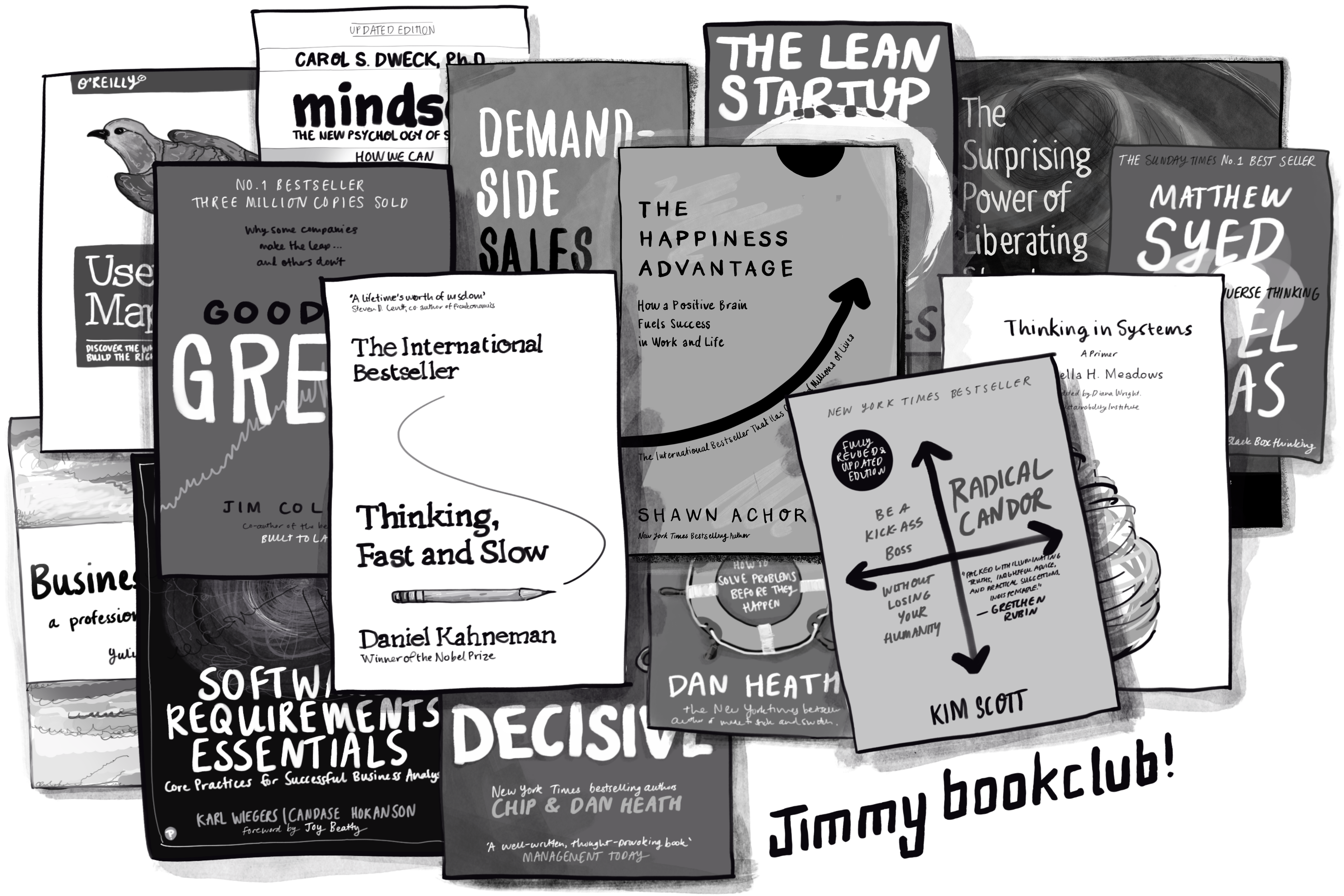
Collection of business and psychology books arranged in an overlapping layout, including titles like “The Lean Startup”, “Thinking Fast and Slow”, and “Software Requirements Essentials”.
If Jimmy ran a book club, this would be the reading list!
The books on this list are those that have influenced, inspired, and/or challenged my work the most. It’s a varied list, which makes sense because my work tends to be varied!
It is also a work in progress. My to-read list is long. I hope that I’ll find new books to add and, further, that there will be books that drop off the list over time. Please let me know what I’ve missed and what books I should read next because you think that they belong here!
After all, the easiest way to keep learning is to keep reading …
The full Jimmy bookclub reading list
- Product books
- Business books
- Books about people!
- Decisive by and
- The Surprising Power of Liberating Structures by and
- Rebel Ideas by
- Radical Candor by
- Books about Thinking
- Personal development books
- Business analysis specific
Book list updated on 1 December 2024
It has been more than six months since I published this article, and I wanted to make sure the list was still awesome (spoiler: it is!). I’ve reviewed and updated it, including shuffling around the list, removing a book, adding a book, and tweaking the text for clarity.
Product books
I really enjoy the product and delivery end of the business analysis spectrum. And happily, there are many books in this space (and many on the to-read list), but I only want to highlight two of them here.
Both these books have shaped how I approach my work in a truly fundamental way.
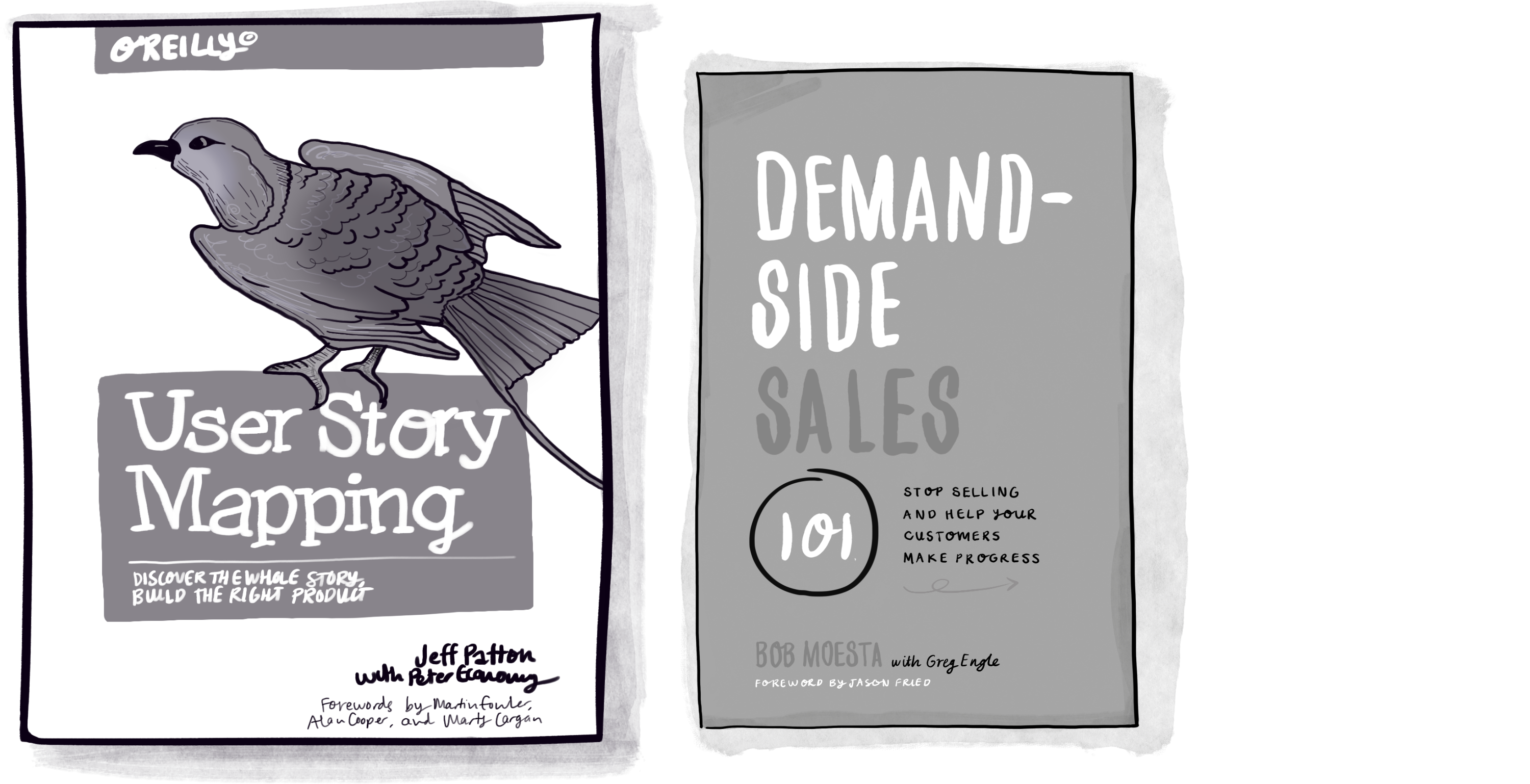
User Story Mapping by Jeff Patton
I’m a self-confessed Jeff Patton fan. And I recently re-read his flagship book: User Story Mapping. You know … just to check that it was as good as I remembered. I can confirm that it is as good as I remembered. And more.
This book is pretty foundational to how I work.
How do I tackle a gig? Essentially, I do as much of the approach outlined in this book as I can get away with: from collaborative decomposition to workshops to opportunity canvases. This book started it all for me. I do like to think that I add some emoji-littered ⚡️sprinkles⚡️ to Jeff’s approach … but, um, that might be debatable.
This book will, of course, teach you the story mapping method, a collaborative backlog decomposition approach that Jeff created. But it will do much more: it will help you to reframe your business analysis in service of a shared understanding from business to development. I’m not overstating it when I say that this book rocked my world!
Also, it cracked me up regularly. Jeff Patton is a funny guy.
Get User Story Mapping here (not free), or read lots of great thinking on Jeff’s website (totally free 👏).
Demand-Side Sales by Bob Moesta
Even if you feel like you know all about jobs-to-be-done — you have watched all the interviews, read all the articles, and feel like you get it — you still have plenty of reasons to read this book! Not least that it is surprisingly fun to read with lots of stories that make the content easy to grasp.
In short, Demand-Side Sales is about reframing how customers interact with your product, from a business-centric perspective on the customer (i.e., supply-side) to focusing on how your product helps your customers to make progress.
But the best part isn’t the stories or the tone — Bob maintains an easy conversational tone throughout — it’s the underlying framework of jobs-to-be-done. The customer-buying journey is easy to understand, yet powerful. And the framework around the buyer’s moment of struggle is deceptively simple, yet hugely illustrative!
So, if you were operating under the mistaken assumption that you had read so much about jobs-to-be-done that reading Demand-Side Sales isn’t necessary … well, you are wrong — just as I was!
Ground yourself in your customer’s journey by reading it.
Business books
It feels as if given my background in business anlysis, my business book list should have more than just two books! 😳
I know, I know, there are many books that I could have included here!
But frankly, I hate most business books. I find them surprisingly unhelpful at most things, including, not least, business! But to avoid sidetracking us into a long article about all the over-hyped business books that are just plain terrible, let me introduce two very good business books:
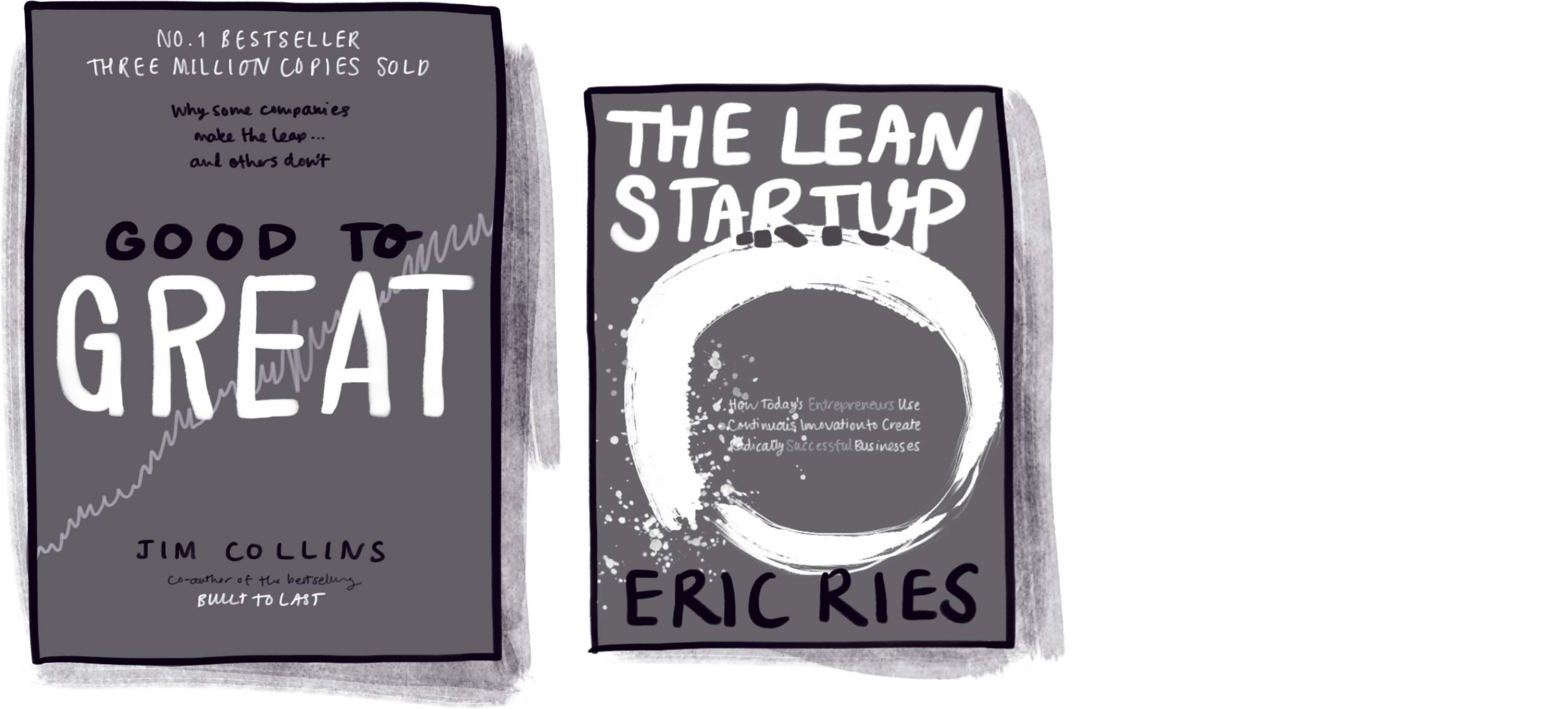
Lean Startup by Eric Ries
This is the original startup book.
It is a tad dated — there certainly was no ChatGPT when this was written — but there are still good lessons here. And learning is what the lean startup is all about. Learning about your customers, learning what they want, and learning what they’ll pay for and whether they’ll buy your idea. Oh, and learning which of your assumptions are wrong AF.
Lean Startup isn’t just for those working in startups! Some of the techniques are fully applicable for those of us working in established ventures and without a massive capital fund to burn through.
I must admit that while re-reading it, I was somewhat irritated at the use of MVP to represent a unit of learning — boy, is this not the most overused term of all time! But, if that’s the only thing that I can complain about, then I think that we can keep the book on the Jimmy reading list.
Lean Startup set me on the path to understanding product management. I also credit it with kicking off the process of reframing my thinking about value from org-centric to customer-centric.
Good to Great by Jim Collins
Given that we work with businesses, it makes sense that we should understand what good business looks like.
The truth is, most of what you believe about what makes a business good is bullshit. And Jim Collins did the research to back that statement up!
He reviewed the performance of more than a thousand companies and identified eleven companies that became great. Then he dug into what makes those companies successful. The results challenge everything we’ve been sold about success stories and big egos (and we certainly have enough egos running around talking smack at the moment)!
If you’re working in the private sector, or want to, this is a good primer. It is a little dated now, but even so, it is still a great read. At bare minimum, it made me more suspicious of the hero CEO schtick, which is reason enough to include it here.
You can read a summary of Good to Great here. Or get the full Good to Great book here.
Books about people
We spend most of our time eliciting information from, communicating information to, and building understanding with people! So if there is any expertise worth seeking in your quest to become better at your job, how people work is it!
The following four books helped me to understand people better and to work with them more effectively.
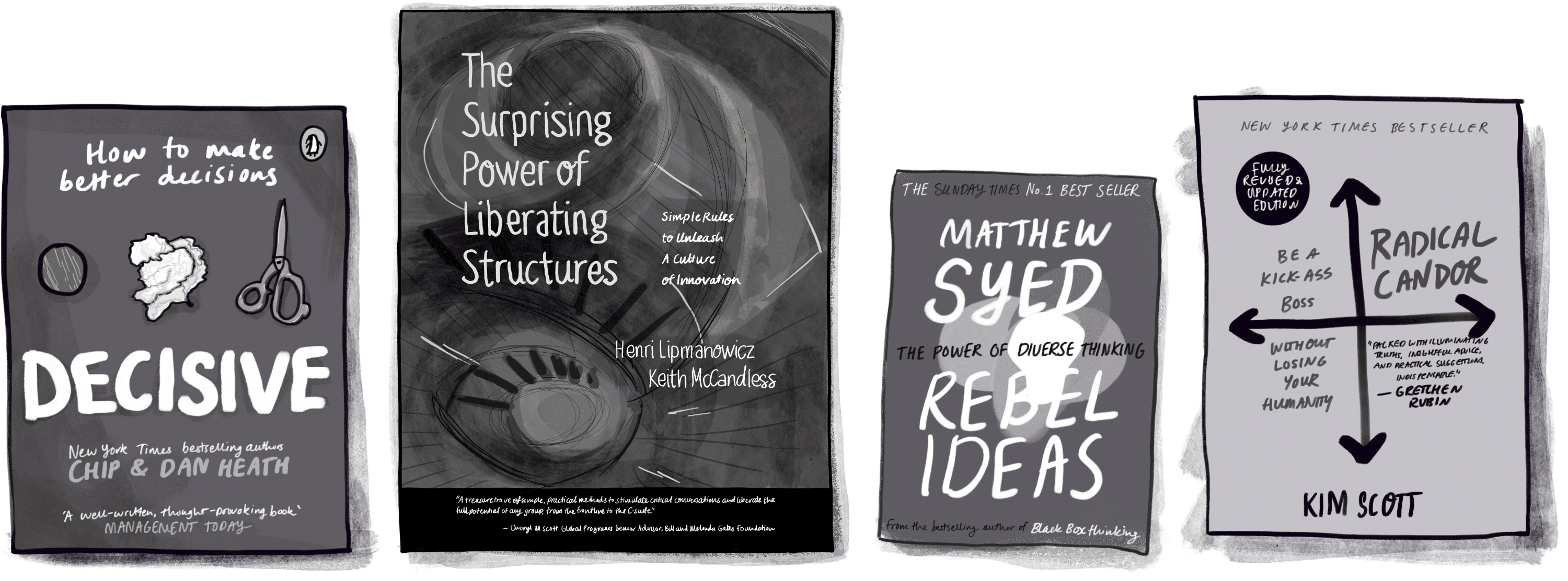
Decisive by Dan and Chip Heath
Until reading this book, I hadn’t really realised just how much of what I do is all about making decisions: decisions about functionality, decisions about priority, decisions about next steps, decisions about approach. And because I’m a contractor, decisions about what role to take next!
This book was the most helpful overview — with detail — of how to make good decisions.
Immediately after reading this book, I found myself suggesting Let’s put some tripwires in place for this
, and Do you think we need to widen our options here?
more often than I expected.
In short, if you’re human, and therefore have to make decisions, read this book. And if you’re a Business Analyst or consultant who helps facilitate decisions: READ THIS BOOK!
The WRAP decision-making framework is summarised in this free PDF.
But that doesn’t really give enough detail to action it properly in the wild IMHO, so if you’re serious, then get the Decisive book here.
Liberating Structures by Henri Lipmanowicz and Keith McCandless
Ever done a requirements review workshop and faced a sea of blank faces? Ever ended up reading a document line by line in an effort to get endorsement from the stakeholders?
We all have … and it’s bloody awful.
There are many things that we do that are more about facilitation and information sharing than anything else. Liberating Structures is one of those books that have a cult following for good reason. It has simple concepts and instructions that help you to think about facilitation in an entirely new way.
Now, there is plenty in the book that I’m not likely ever to use unless I throw in the business analysis towel and become a full time facilitator or coach of some kind, but the few things that I have taken from this book have helped me to create both better engagement and better outcomes.
It is less a book that you read from cover to cover and more a book that you’ll reference when needed.
My recommendation: read User Story Mapping first (see the product section), then bother with Liberating Structures only if you’re doing facilitation regularly, or if facilitation is a skill that you want to improve!
Also great: Training from the Back of the Room. Consider getting this book if you’re doing a lot of training in your role, or if teaching is of interest. But note that there’s a ton of courses and articles on this method, so do an internet search before committing to purchasing the book.
Rebel Ideas by Matthew Syed
Many books about innovation feel like really long pamphlets on how awesome the author is.
Thankfully, Rebel Ideas does not.
This is a book about how diverse teams make better decisions, are more innovative, and perform better. It covers topics such as collective blindness, constructive dissent, and how innovation actually works. It’s an informative and enjoyable read that will make you think hard about your team and how they work together.
It challenged (and changed) my thinking about stakeholders for the better through dire predictions and black hat
thinking. I also suspect that it might have made me an all-around better human being. But that’s slightly harder to prove. Yeah … I’m gonna go with it anyway.
I especially recommend it if you flinch from negative feedback. If you want to be great at business analysis (hell, any job), you must be able to cope with healthy debate. This book will help!
Get Rebel Ideas here or at most book sellers.
Well, crap
Argh! I’m super bummed to report that when I followed Matthew Syed on social media, I discovered he has some seriously gross opinions on many things. So gross that I’ve unfollowed him, something I rarely do!
While I do believe that even people with shitty attitudes can produce interesting things, I didn’t want to just continue to promote his book here without comment because some of his views are just fucking abhorrent and there’s no other way to put it:
The book is still great. Was it ghost written? Still, I doubt I’ll read more from him.
Radical Candor by Kim Scott
I was once asked in an interview about my leadership approach and how I would manage a team. I answered: You know the book Radical Candor by Kim Scott? Yeah … I’d do what she says.
And I wasn’t being facetious at all.
Reading this book was a revelation to me. It articulated all the things that I look for in a boss, and all the things that I aspire to be to the people that I’m managing or supporting.
I don’t manage people full time, so I have not been able to implement her systems completely. Yet. But elements of her approach have influenced how I mentor, manage stakeholders, and operate in a team. She avoids the leadership label, but at heart, that’s what this book is about. And you don’t need to be a boss to be a leader.
Note: there is a bit too much name dropping in the book for me, which is slightly eye-roll-inducing, but comes with the management territory, I guess!
Thinking books
Things interact in interesting ways, sometimes annoyingly so. Often, our job is to pick them apart, and then work out what happened. In other words, the ability to think critically is, um, critical.
Here are three books that have helped me in the think department:
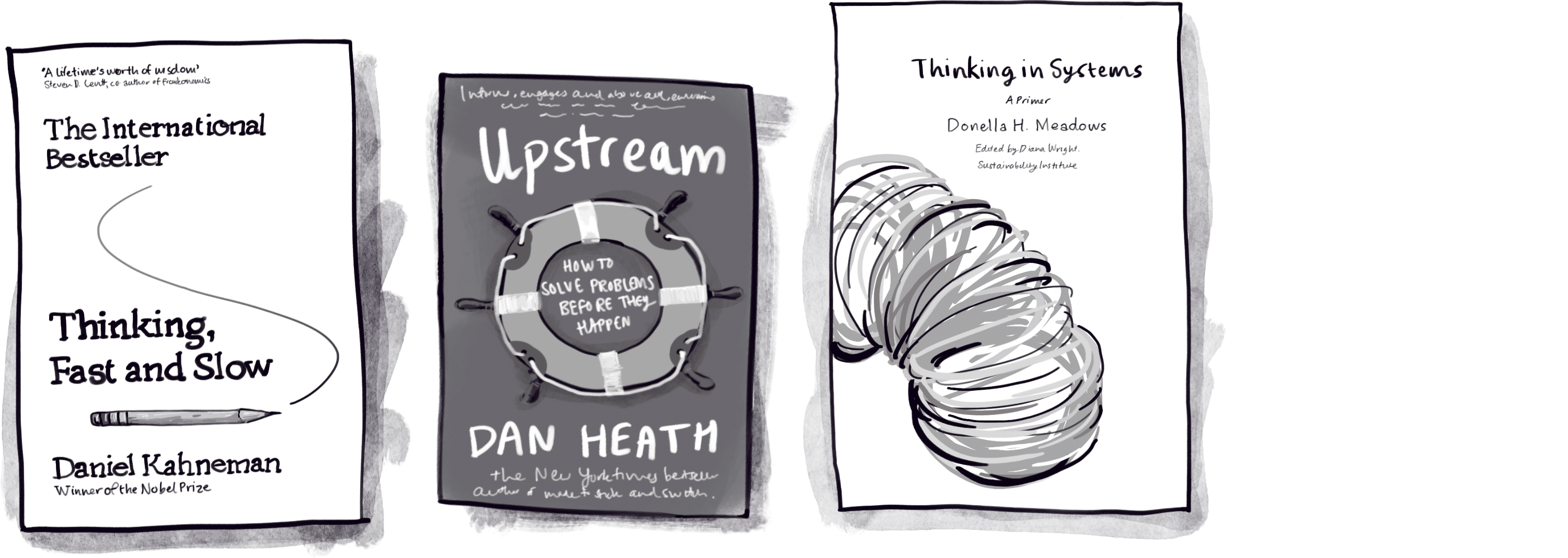
Thinking Fast and Slow by Daniel Kahneman
Thinking Fast and Slow is a popular book on psychology. Emphasis on the word popular. This book is so popular that including it here feels a bit cringey. It’s like the head cheerleader being crowned prom queen: totally expected and therefore a bit lame.
The problem is: this book really is that good!
In this bestseller, Daniel digs through cognitive biases, how we make choices, and how we humans experience life. He will help you to see that we humans are rarely as rational as we like to think that we are!
I don’t want to belabour this description because there are already a million glowing reviews out there, but let me just say that the content of this book makes regular appearances in my mulling commentary. Such as when I’m reflecting on how something played out, or trying to puzzle out people’s responses to something. When I do, I look for applicable patterns from this book. Like a small Hannah-sounding-like-Daniel-Kahneman in my brain wondering if the issue has truly been framed correctly.
In other words, the reviews are right. You should read this book.
Upstream by Dan Heath
I enjoyed this book so much that within a day of finishing it, I had already started one of his other books (Decisive — see the books about people section above).
There is a reason that so many people rave about this book. It is a very easy-to-read, entertaining introduction to systems thinking, teeming with relatable examples and anecdotes. It provides a happy balance between teaching you approaches to help you to fix problems — rather than just addressing symptoms — and making the learning fun with amusing personal anecdotes. It is entertaining enough to avoid feeling like learning, if that makes sense.
And the questions this book asks about impact and how to make sure that we’re doing things correctly are right up the alley of any serious Business Analyst, Outcomes Engineer, or consultant.
Thinking in Systems: A Primer by Donella Meadows
This is a recent addition to my library: an oldie but goodie.
Donella finished the first draft of this book in 1993, but died before it was published. I’m including this fact because reading this book feels like you’re listening to your elderly-but-still-smart-as-a-whip aunt who is helping you to understand how the world works.
Littered with stories, great quotes, and diagrams with taps, all told in a matter-of-fact tone, Thinking in Systems made me mull. A lot. Like A LOT a lot. And trust me, I’m an obsessive muller, so that’s really saying something.
I’m not going to lie, it’s not necessarily an easy read — dry is a word that comes to mind — but it is widely acknowledged as the best intro to systems thinking out there: a fact to which I can attest as I’ve tried to read quite a few of them!
I haven’t entirely figured out how to apply systems thinking to my work yet — as you might have noticed — but I am convinced that systems thinking (and lots of reading on the topic) has made me more considered in my approach.
Books for personal development
Excellence comes from growth. And to set yourself up for growth, you need to understand how you are holding yourself back.
These two books helped me:
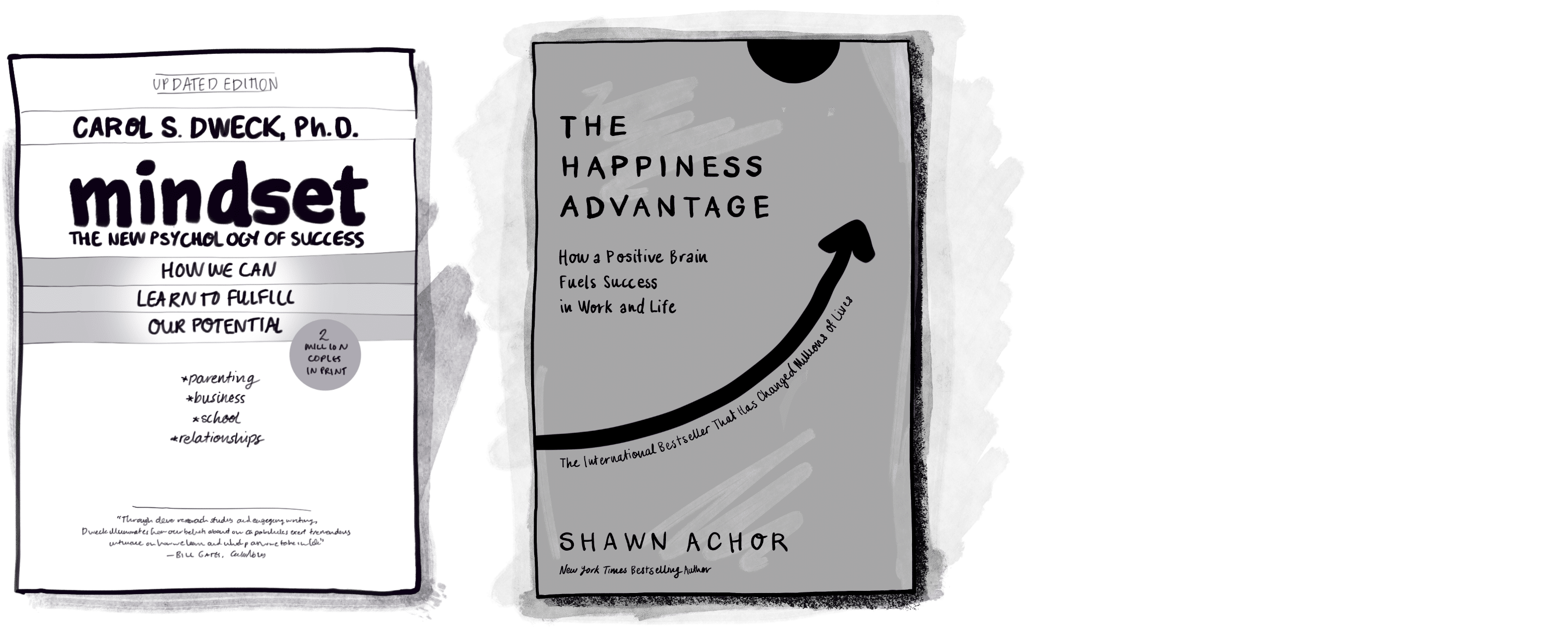
Mindset by Carol Dwyek
Heard of the concepts of fixed and growth mindsets? Well, this book is where those concepts originated.
Having a good mindset is a necessary foundation to doing good work. As a Business Analyst, consultant, or Outcomes Engineer, you are expected to be able to operate in situations where you often don’t know what’s happening (yet).
To cope, you need a healthy mindset. You need a growth mindset.
Even if you’re familiar with the concepts, I recommend that you read Mindset. I would have sworn that I had a growth mindset prior to reading Carol’s book, but her book challenged that belief. It helped me to build a much more nuanced view of my own mindset, which meant that I was able to chip away at the parts of it that were holding me back — a work in progress, I’ll admit!
The Happiness Advantage by Shawn Achor
Every night before we go to sleep, my partner and I each share three things from that day for which we’re grateful. We call this practice, three things. It is without a doubt one the most beneficial activities for my mental-health that I do.
This book by Shawn Achor is what gave me the original idea!
Shawn is a Happiness Researcher, and his book The Happiness Advantage is based on the research he did on happiness while at Harvard University. In it he explains that the commonly held formula for success is broken. Success does not make us happy. In fact the opposite is true: happiness makes us successful!
But there is more! Shawn identified seven things — a gratefulness practice being one of them — that have a proven impact on your happiness! All delivered in an easy-to-read, actionable, no-nonsense way.
At the very least, watch Shawn’s TedX talk on his happiness research, which is what convinced me to buy his book in the first place. But fair warning: he delivers it all at such a rapid pace that you’ll find yourself out of breath just watching him!
Business analysis
It would be weird not to have business analysis books in the mix, no?
My only question is, are two enough?
FYI, I one hundred percent know that this part of the list will change. I’m actively reading a stack of BA books, and it would be madness to think that none of them will make this list.
So, even more so than the previous sections, think of this section as a work in progress which I fully intend to grow! Until then, here are two business analysis books that I highly recommend.
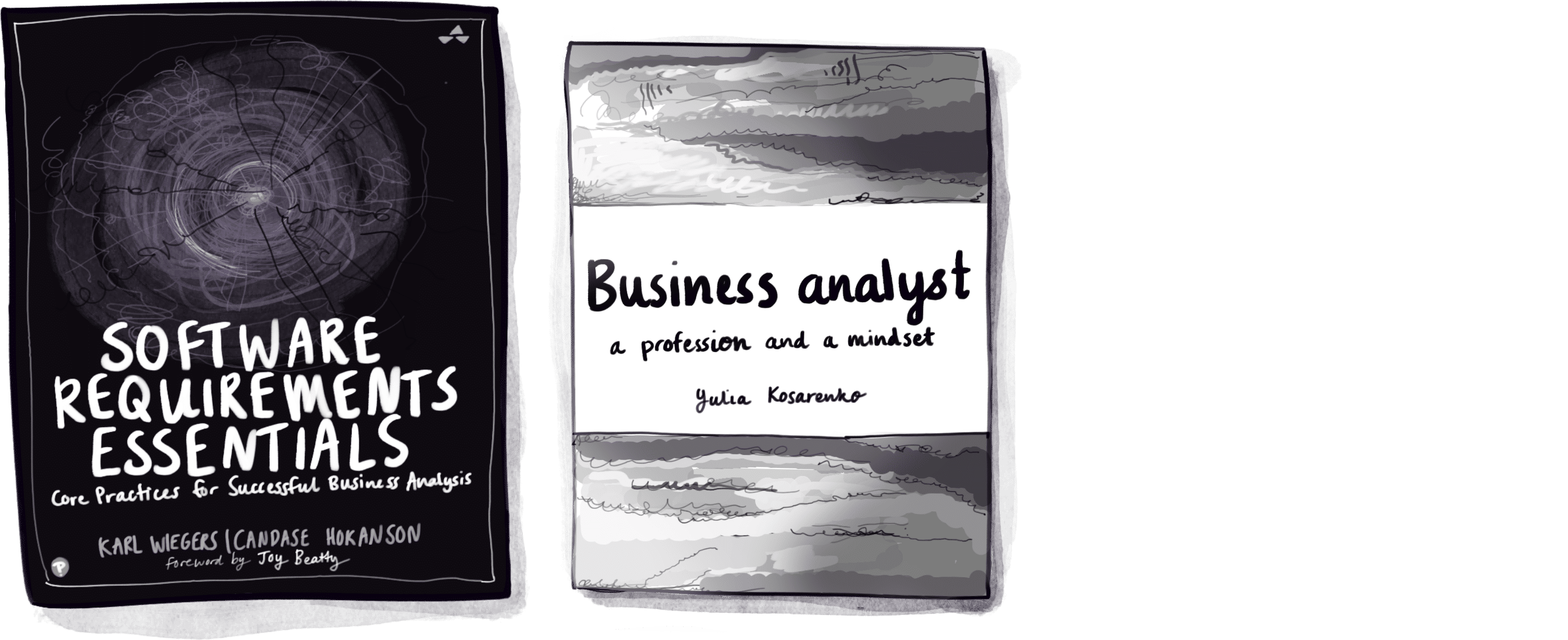
Software Requirements Essentials by Karl Wiegers and Candase Hokanson
I don’t think that there is a better, more succinct summary of all things requirements and business analysis. Karl and Candase condense the essentials down to twenty that they’ve identified as the core practices for successful business analysis … which is perhaps the driest description of a book on this list.
The fun part is that Software Requirements Essentials is anything but dry. Karl and Candase have a sneaky wit and charm that make the book not just informative, but fun. It is obvious that they really do love this stuff and do it well.
The book is both entertaining and truly captures the essentials you need to create requirements well.
So, if you want to work in IT development, I cannot recommend the book too highly. And at one hundred and fifty-six pages (not counting appendices and the index), it is a remarkably easy read given the solidness of their advice.
Business Analyst: A Profession and a Mindset by Julia Kosarenko
A special recommendation for those of you just starting your a Business Analyst career!
I suspect that I learned all the lessons in this book the hard way — an approach I absolutely do not recommend. Do not do what I did! Instead, read this book.
This is the first book that I’ve read that captures the true scope of the BA role and the delicate balance that the role requires between analytical skills and people skills. By the end of the book, you’ll have a better handle on your role, you’ll have some great tips, and you’ll probably be excited about diagrams — as is only right!
Or, if you’re a student and don’t want to fork out for the actual book, then I highly recommend her other content on all manner of business analysis related topics.
That’s it!
That’s all the books! Just fifteen of them! You’ll be done in no time.
Happy reading!
Last updated .